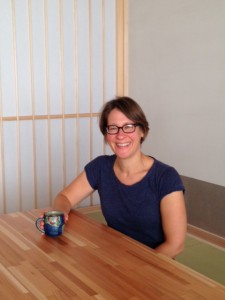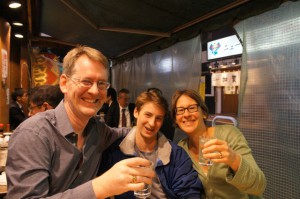ELSI Blog
52 My Visit to ELSI

There's a certain activation barrier necessary to cross for adventure. So I arrived in Tokyo already energized and ready for interaction. John Hernlund met me at ELSI and showed me to my comfortable room at the International House adjacent to the Tokyo Institute of Technology Oookayama campus. I had arranged for spring sabbatical time away from my normal life as a UCLA mineral physics professor so I could spend time at ELSI talking with people about "what makes a planet able to support life?" and working on my own electrochemistry projects that seek ways to address that question. Less than 24 hours after I boarded the plane in LA, I arrived at ELSI refreshed and ready to begin my too -brief time as a visiting scientist at the Earth-Life Science Institute at Tokyo Tech.
I was immediately incorporated into the flow of work and life at ELSI, working in the downstairs common rooms, and talking with people from many fields--physics, astrophysics, origin-of-life, geochemists, and planetary interior dynamicists. There is always people-activity around the coffee & tea machine watering holes, and everyone (it seems) attends the almost-daily seminars. The permanent staff--both research and administrative--anchor down the flux of scientific visitors, and it all contributes to the sense of excitement and promise of a scientific startup, with a focus on ideas. Everywhere in the world, scientists are my people: driven by curiosity and trained in asking clear questions and making evidence-based decisions. While at ELSI, I lived and learned Japanese life and culture, and all within the context of the prevailing warm and welcoming international scientist culture.
One of the highlights of my visit was seeing all of the amazing high pressure, temperature research happening in Kei Hirose's research group. Petrology--the study of rocks, but really phase diagrams, distribution coefficients, mass transport properties--is incredibly difficult at very deep Earth conditions, like at the interface of mantle and core--and Hirose-san's group is doing groundbreaking scientific and technical work required to establish techniques of petrology at extreme conditions, and getting some amazing measurements and results. And data! I love looking at data! Almost every afternoon during my visit, a group of the mineral physics researchers show me their measurements, their results, their interpretations, and we sat and discussed them. I enjoyed my role as "auntie advisor."
My visit coincided with visitors from the computational infrastructure group in geophysics Eric Heien and Hiro Matsui from UC Davis. Together with our hosts John Hernlund and Christine Houser we discussed planetary mantle and core dynamics, interactions at the core/mantle boundary of the Earth, while exploring Tokyo with dual emphases on ramen noodles (lunch) and Sake/Izakaya (evenings). My family--husband Jim and 15-yr-old son Emmett--joined for the second half of my visit. They explored during the day, and we all joined together for evening explorations around Tokyo. Jim and I took the opportunity to reconnect with many of our Japanese colleagues from our grad student days at UC Berkeley. It's so much fun to fast-forward 15-20 years and pick up where we left off with old friends--and introduce the next generation to each other, no longer little kids, but people poised to explore the world. Multiple plans for Japan-US children-exchanges were made.
I came home enriched by sakura sights, Tokyo metro adventures, and hot-pot extravaganzas at John and Christine's, and energized for scientific explorations of Earth's formation and development into the complex life-supporting world it is now. I am looking forward to future visits and scientific exchanges with ELSI.












